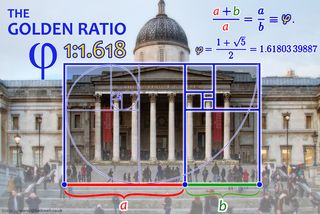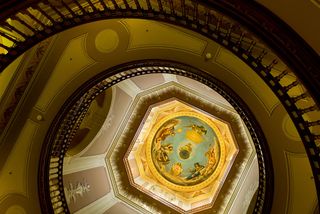
The Golden Mean: A Great Discovery or Natural Phenomenon? (Op-Ed)

This article was originally published at The Conversation. The publication contributed the article to LiveScience's Expert Voices: Op-Ed & Insights.
What do the façades of the National Gallery in London’s Trafalgar Square and the Sydney Opera House in Australia have in common?
Most people would suggest the two buildings have few similarities – the former is symmetrical and classically proportioned, whereas the latter is modern, organic and curvilinear.
An architect might offer the provocative answer that both buildings feature compositions of geometric shapes, combing circles, squares and rectangles. But this answer is not the reason the two are linked in popular culture.
Instead they can be found on the lists of buildings that allegedly rely on the Golden Mean, described below, to achieve a perfect aesthetic composition.
The Golden Mean – also known as the Golden Section or the Divine Proportion – is a mathematical concept that is typically traced to the 15th century, a period in which geometry served both practical and symbolic purposes.
It is a ratio that defines a recurring relationship between a larger element and a smaller subset of that element.
Sign up for the Live Science daily newsletter now
Get the world’s most fascinating discoveries delivered straight to your inbox.

In simple mathematical terms, if a line ab is divided by a point C, such that the ratio of the whole line (AB) to the longer segment (AC) is equal to the ratio of the longer segment (AC) to the smaller segment (CB), then the ratio AB : AC (and, of course, the subset ratio AC : CB) is known as the Golden Mean (φ or “phi”).
So, for example, if the length of the starting line AB is 1.000, then the Golden Mean is approximately 1.618.
When the Golden Mean is conceptualised in two dimensions it is typically presented as a regular spiral that is defined by a series of squares and arcs, each forming “Golden Rectangles”.
Used by ancient architects
There is evidence that Ancient Egyptian, Roman and Greek architects were able to produce this ratio using simple tools and, like their 15th-century counterparts, may have viewed it as having a larger figurative significance.
This symbolic potential arises because of the way the mean’s spiral shape resembles growth patterns observed in nature and its proportions are reminiscent of those in human bodies. Thus, these simple spirals and rectangles, which served to suggest the presence of a universal order underlying the world, where thereby dubbed “golden” or “divine”.
For the ancient architect, the Golden Rectangle must have offered a recipe for creating buildings that were easy to draw, pleasing to the eye and, most importantly, could be justified on the basis that they represented a connection to god or the universe.
At a time when, for the architect, beheading was a more common risk than litigation, the Golden Section offered a special type of indemnity.
However, while most symbols of the ancient world have now lost their power, the Golden Mean still enjoys a cult following, with many hundreds of websites showing its spiral form overlaid on sunflowers, shells, famous paintings and the faces of popular actors. The contemporary cult of the Golden Mean presents these overlays as evidence of the hidden secret of the universe.
The problem with such claims is that researchers have repeatedly demonstrated that the Golden Mean is not a universally attractive proportion and it is not statistically significant in nature or in the human body. But the fact that its more mystical properties have been comprehensively refuted should not be used to relegate this theory to the category of esoterica.
Natural geometry
Like all aesthetic ratios (Le Corbusier’s “Modulor” and van der Laan’s “Plastic Number” are equally worthy), its broad application in design provides a degree of order and consistency to a work, something important in architecture because a building is rarely experienced from a single distance.
Using any of these ratios, an architect can design a door handle that has a complementary relationship to its door, which in turn has a similar relationship to its enclosing wall, and so on. Proportional systems are useful for this purpose but their presence, in even a great building, should not be regarded as especially significant.

In the 1980s, experiments were undertaken wherein children were given rulers and pairs of compasses and encouraged to draw shapes. It wasn’t long before the first circles and squares were produced, then triangles, grids and arcs, and before the end of the first hour, Golden Rectangles began to appear.
Does this imply that the Golden Mean is embedded in every child’s subconscious or is it simply a shape that arises naturally from the use of this particular set of tools?
It will be remembered that both the National Gallery and the Sydney Opera House – mentioned at the start of this article – are compositions of rectangles and arcs, drawn in both cases by architects using a ruler and a pair of compasses. These were also drawn by architects (respectively William Wilkins and Jørn Utzon) who were aware of the classical tradition and of its geometric tropes.
For both of these reasons, the presence of something loosely approximating a Golden Mean should not be regarded as a great discovery, but it could be a sign that the architect had been trained to appreciate the need for consistency within a design.
Michael J Ostwald receives funding from the ARC.
This article was originally published at The Conversation. Read the original article. The views expressed are those of the author and do not necessarily reflect the views of the publisher. This version of the article was originally published on LiveScience.












